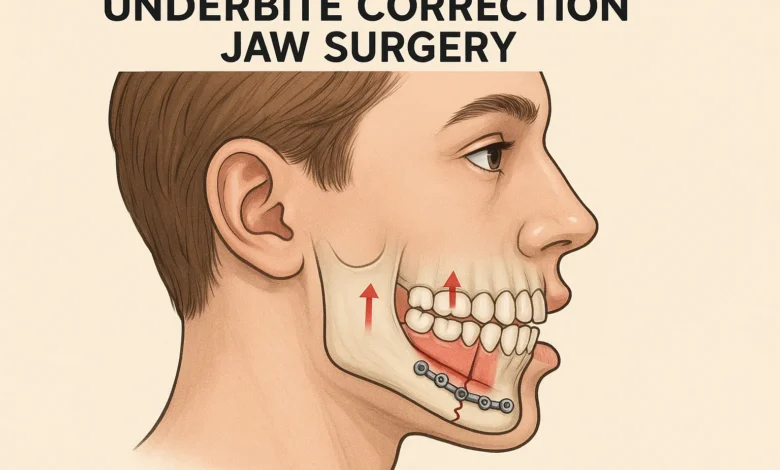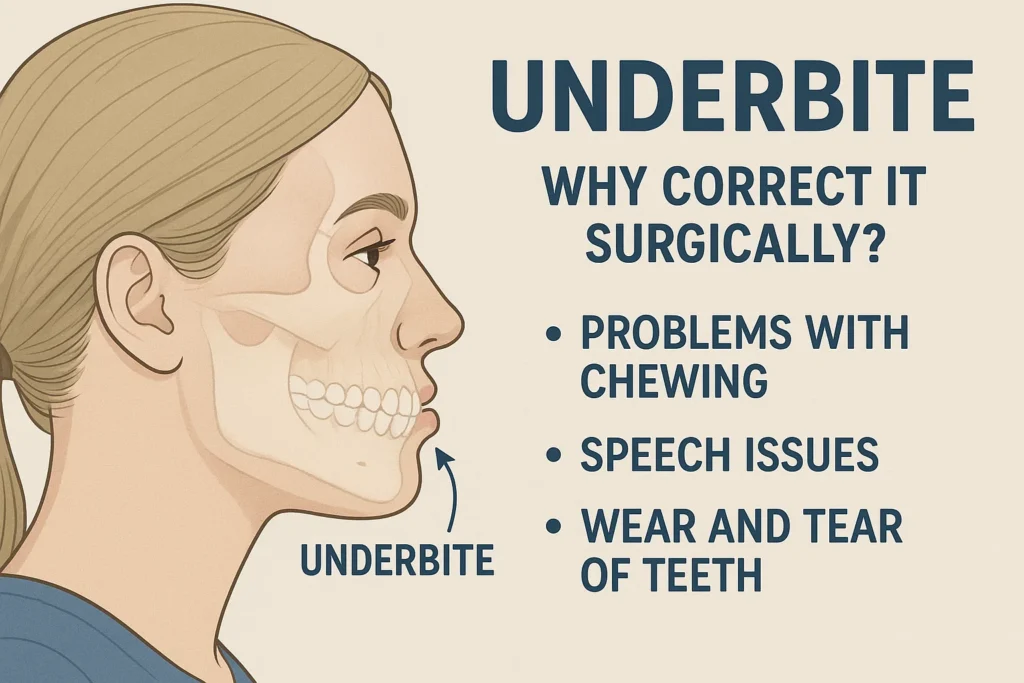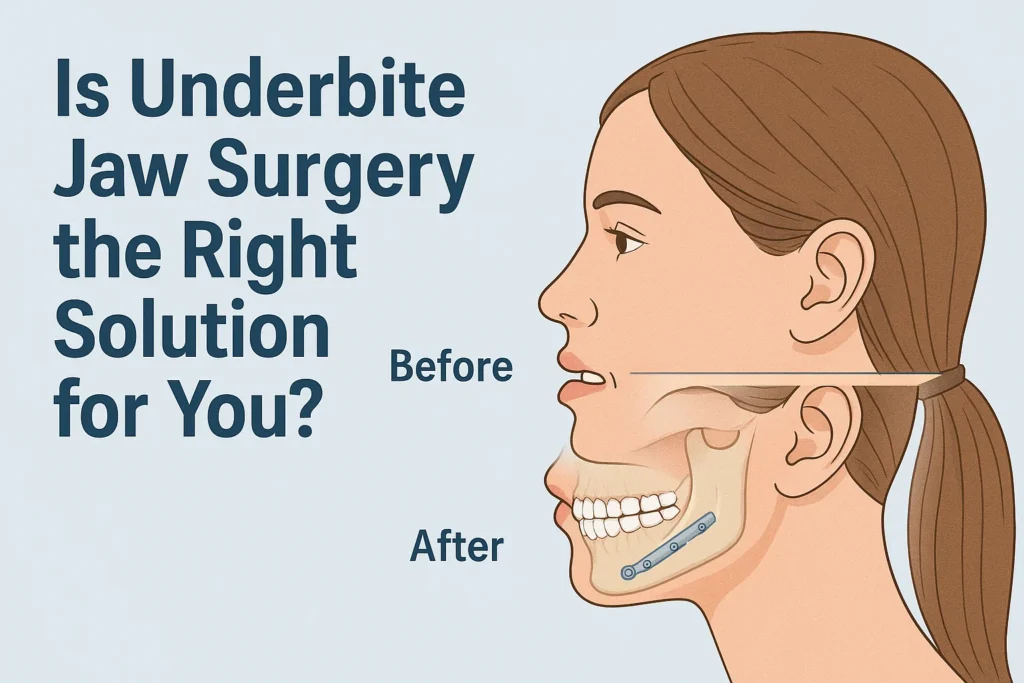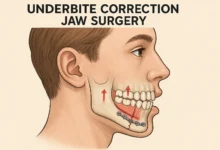Underbite Correction Jaw Surgery: What to Expect Before & After

Underbite Correction Jaw Surgery: Your Comprehensive Path to a Healthier Smile
The underbite correction jaw surgery or orthognathic surgery as it is called in the medical field, is a life transforming solution that not only reinstates the appearance but also the functionality. This ultimate resource cuts through the array of confusion and offers a level of expertise step by step guide of what to look forward to during the process of initial consultation all the way to full recovery. We will enable you to make an informed choice on your health.
What is an Underbite, and Why Correct It Surgically?

An underbite, or prognathism, occurs when the lower jaw (mandible) protrudes forward past the upper jaw (maxilla). This misalignment isn’t just about aesthetics; it’s a functional problem with real health consequences.
The Root Causes of a Severe Underbite
- Genetics: The most widespread one. You are prone to having one in case your parents had jaw discrepancies.
- Childhood Habits: When a child sucks the thumb or thrusts the tongue or uses a pacifier, it may affect the growth of the jaw.
- Injury or Trauma: Although a problem in the jaw was fractured, and healed badly, it may lead to misalignment.
- Tumors: Rarely the growth of the jawbone can be influenced by the presence of tumors in it.
The Hidden Health Consequences of an Untreated Underbite
Living with an uncorrected underbite can lead to a cascade of issues. Research shows that individuals with significant underbites are at a higher risk for:
- Temporomandibular Joint Disorder (TMD): Pain, clicking and locking of the jaw joint which is a chronic condition.
- Excessive Tooth Wear: The erosion of enamel occurs too early as a result of erroneous tooth contacts.
- Chewing and Digestion Problems: The digestive issues can be caused by the inefficient chewing.
- Speech Difficulties: Speech lisps or other articulation disabilities may be present.
- Sleep Apnea: This jaw position may help to obstruct airways when one sleeps.
When these issues are present, orthodontics alone is like putting a bandage on a structural problem. Underbite correction jaw surgery addresses the root cause—the jawbone itself.
Is Underbite Jaw Surgery the Right Solution for You?

How do you know if your case is severe enough to warrant surgery? The decision is a collaborative one between you, your orthodontist, and an oral and maxillofacial surgeon.
The Key Indicators for Surgical Intervention
You may be a candidate for underbite correction jaw surgery if you experience:
- Jaws closed at significantly different heights.
- Constant pains on the face or headaches.
- Failure to chew food adequately or even bite into some foods (such as an apple).
- Difficulty with breathing such as mouth breathing and sleep apnea.
- There is notable facial asymmetry.
- Your orthodontist has discovered that the skeletal discrepancy cannot be corrected with the use of braces alone.
Pro Tip: The ideal age for this surgery is typically after jaw growth has stopped, usually in the late teens to early adulthood. However, it can be successfully performed on healthy adults of any age.
The Two-Part Process: Orthodontics and Surgery Working in Tandem
Many are surprised to learn that the journey begins with braces. This is a carefully orchestrated process that can take 1-3 years from start to finish.
Phase 1: Pre-Surgical Orthodontics (12-18 Months)
By the orthodontist, unlike intuition, no effort will be made to fix the underbite using braces. Instead they will correct your teeth- by shifting them into proper positions, in every jawbone, which, in the meantime, tends to increase the underbite. This is an important procedure since it helps in placing the teeth so that they would fit after the jaws are surgically fixed in place.
Phase 2: The Surgery Procedural itself.
When your teeth are ready in proper pre-surgical positions, you will be subjected to the operation. A Bilateral Sagittal Split Osteotomy (BSSO) is the most prevalent practice of an underbite. The simplified breakdown is herein:
Anesthesia: You are going to be put under general anesthesia so that you can be comfortable.
Incisions: The surgeon cuts the mouth inside (and thus no visible scars).
Osteotomy: A lower jawbone is cut carefully, controlled, and in the back of the molars.
Repositioning: The whole lower jaw with your teeth in it gets moved backwards into its position.
Fixation: The fixation is the fixation of the bone in its new position by means of small titanium plates and screws.
In other instances, a procedure may be done on the upper jaw to move forward (Lefort I Osteotomy), or the chin (genioplasty) surgery. Your surgeon will work out the plan to your anatomical peculiarities.
Phase 3: Post-Orthodontics Surgical (6-12 Months)
Your orthodontist finalizes the fine-tuning of your bite, once he/she has healed and is certain that everything is in place and perfect in your mouth, he/she removes the braces.
Weighing Your Options: Surgery vs. Non-Surgical Alternatives
It’s essential to understand when non-surgical methods are viable and when they are merely a compromise. The following table clarifies the key differences.
| Factor | Jaw Surgery (Orthognathic) | Non-Surgical (Braces/Invisalign Only) |
|---|---|---|
| Best For | Skeletal (bone-based) underbites with functional issues. | Dental (tooth-based) underbites or very mild skeletal cases. |
| Corrects | The actual jawbone position and teeth. | Tooth position only; camouflages the underlying jaw issue. |
| Functional Improvement | Significant improvement in chewing, breathing, and joint health. | Minimal to no functional improvement. |
| Facial Aesthetics | Can dramatically improve profile and facial balance. | Limited change to facial profile. |
| Treatment Time | Longer (18-36 months), including recovery. | Shorter (12-24 months). |
| Cost | Higher (often partially covered by medical insurance). | Lower (typically considered dental-only expense). |
The Road to Recovery: What to Expect After Underbite Surgery
Understanding the recovery timeline is key to managing expectations and ensuring a smooth healing process.
The First 2 Weeks: The Liquid Diet Phase
This is the most difficult stage. There is going to be a lot of swelling and your diet will be limited to liquids only (broths, protein shakes, blended soups). The pain is treated using drugs. Rest is absolutely critical.
Weeks 3-6: The Soft Foods Phase
Edema will reduce significantly. You can move on to soft no-chew foods, such as mashed potatoes, scrumbled eggs, and cooked pasta. During this period a lot of individuals go back to either office jobs or school.
Months 2-6: The Return to Normalcy.
Majority of the swelling will go down, and you will incrementally resume normal food as recommended by your surgeon. You will be enjoying the functional and aesthetic advantages of your new bite.
Caution: It is normal to have the momentarily numbness of lower lip, chin, gums. The feeling usually resumes in a few months although in a few instances, certain numbness becomes permanent.
Frequently Asked Questions (FAQ) About Underbite Jaw Surgery
What is the typical cost of underbite correction jaw surgery?
Its price may vary between 20,000 and 50,000 and probably more, based on the experience of the surgeon, location, and the complexity of the procedure. The most important aspect is that since it is a medically necessary operation, the surgical part of it is usually not paid out of pocket, as it is a medical expense, whereas the orthodontic part is a dental cost.
Are the outcomes of jaw surgery lasting?
Yes, the outcomes are deemed to be permanent. The jawbones can be considered stable as soon as they have healed in their new position. Nevertheless, you need to wear your retainer as advised by your orthodontist in order to avoid having your teeth shift out of position with time.
What is the pain level of the recovery process?
The most important pain period is the initial 3-5 days, which can be adequately treated with a prescription drug. The pain soon turns into the one of tightening and pressing. Majority of the patients recount that the experience is less characterized by the intensive pain than by inconvenience of a liquid diet and swelling.
Which risks and issues can be involved?
Like with any great operation, there is the chance of infection, bleed, anesthetic reaction, and nerve damage (possibly resulting in numbness). The complication rate is however low in the hands of an experienced, board-certified oral and maxillofacial surgeon. Research has shown that the patient satisfaction rates in this surgery are extremely high and in most cases they are above 90%.
Can surgery be done without braces?
No, in by far the majority of instances, pre-surgical orthodontics is necessary to get the teeth to fit together satisfactorily after the jaws have been relocated. Very rarely, and very special cases exist that are, however, open to surgery-first, though that still necessitates orthodontics post-surgery.
Conclusion: Reclaiming Your Smile and Your Health
Making a decision to go under the scalpel to make an underbite correction is a serious one. It is a process that has to be very patient, committed, and trusting to your medical team. However, the payoff is tremendous: the solution that extends way past the level of aesthetics to provide long-term alleviation of pain, turnaround of eating and speaking capabilities, and enhance the overall quality of life. And not merely changing your profile but rebuilding your health back to the bottom.
Your Next Step: In case you are thinking about such life-changing treatment, the most important step you can take is to make an appointment with qualified orthodontist and oral and maxillofacial surgeon. They are able to give a very accurate diagnosis, an individualized treatment plan, and provide all your particular questions. Uncertainty should not stop you to the healthy and functional smile you deserve.
Dental Insurance Covers Whitening: Tips to Maximize Your Benefits
